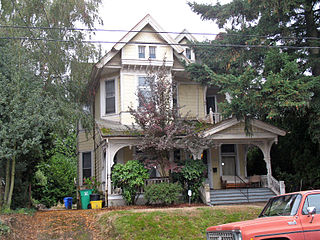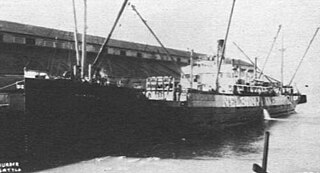
Union Iron Works, located in San Francisco, California, on the southeast waterfront, was a central business within the large industrial zone of Potrero Point, for four decades at the end of the nineteenth and beginning of the twentieth centuries.

St. Johns is a neighborhood of Portland, Oregon, United States, located in North Portland on the tip of the peninsula formed by the confluence of the Willamette River and the Columbia River. It was a separate, incorporated city from 1902 until 1915, when citizens of both St. Johns and Portland voted to approve its annexation to Portland, which took effect on July 8, 1915.

Albina is a historical American city that was consolidated into Portland, Oregon in 1891.
USS Rail may refer to the following ships of the United States Navy:

Willamette Iron Works was a general foundry and machine business established in 1865 in Portland, Oregon, originally specializing in the manufacture of steamboat boilers and engines. In 1904, the company changed its name to Willamette Iron and Steel Works, under which name it operated continually until its close in 1990.

Lightship No. 114, later U.S. Coast Guard WAL 536, that served as lightship Fire Island (NY), Examination Vessel, Diamond Shoal (NC), 1st District relief vessel, Pollock Rip (MA) and Portland (ME). After decommissioning in 1971, in 1975 the lightship became a historic ship at the State Pier in New Bedford, Massachusetts. She received little maintenance, and eventually sank at her moorings in 2006 and was sold for scrap the next year.

SS Point Bonita was constructed in 1918 and launched 27 March 1918 after a hull being built for foreign owners at Albina Engine and Machine Works was requisitioned during World War I by the United States Shipping Board (USSB). The ship saw service as the Navy transport USS Point Bonita, assigned Identification Number 3496, from 7 October 1918 to 7 April 1919, was returned to the USSB and saw civilian service with several commercial companies as San Pedro and Oliver Olson before again seeing service in World War II as USS Camanga (AG-42). After return to commercial service as Oliver Olson the ship was wrecked at the entrance to Bandon harbor in Oregon.

USS Majaba (AG-43/IX-102) was the Design 1049 cargo ship Meriden built in 1919 by the Albina Engine & Machine Works, Portland, Oregon. All the ships were requisitioned by the United States Shipping Board (USSB) for World War I service. The ship was bought by the E. K. Wood Lumber Co., of San Francisco, California in 1923 and renamed El Capitan. The ship was chartered by the U.S. Navy through the War Shipping Administration (WSA) in April 1942 and commissioned as Majaba.

USS Besboro (AG-66) was built as Caddopeak, a United States Shipping Board (USSB) Emergency Fleet Corporation Design 1049 cargo ship built by Albina Engine & Machine Works, launched 18 October 1918. From 1922 Caddopeak served several commercial shipping companies until sold in 1937 to Burns Steamship Company and renamed Lurline Burns. On 2 February 1942 the ship was delivered to the War Shipping Administration, allocated to the United States Army and operated by Burns and Alaska Steamship Company under an Army charter agreement.
United Streetcar, LLC, was an American manufacturer of modern streetcars, located in the Clackamas area in the southeastern suburbs of Portland, Oregon, founded in 2005. It was the only U.S. company building modern streetcars—as distinct from light rail cars or new replicas of historic streetcars—until 2013, when Brookville received its first order for a modern streetcar, for the Dallas Streetcar.

Oregon Iron Works, Inc. (OIW) is an American manufacturer of complex structural components and systems and specialized vehicles, located in the Clackamas area in the southeastern suburbs of Portland, Oregon. Established in 1944, it is involved in a number of different industries, supplying products ranging from high-speed boats for military use to purpose-built girders for roadway bridges. It has production facilities in Clackamas and in Vancouver, Washington, and currently employs about 400 people. In May 2014, the company announced that it was merging with Portland-based Vigor Industrial.

The Oregon Pony was the first steam locomotive to be built on the Pacific Coast and the first to be used in the Oregon Territory. The locomotive, a geared steam 5' gauge locomotive with 9"X18" cylinders and 34" drivers, was used in the early 1860s to portage steamboat passengers and goods past the Cascades Rapids, a dangerous stretch of the Columbia River now drowned by the Bonneville Dam. Steamboats provided transportation on the Columbia between Portland, Oregon and mining areas in Idaho and the Columbia Plateau. Portage was also necessary at other navigation obstructions, including Celilo Falls.
Vigor Industrial (Vigor) is an American shipbuilding, shiprepair, and industrial service provider in the Pacific Northwest and Alaska. Based in Portland, Oregon, the company consists of several subsidiary companies for a combined total of seven facilities with ten drydocks, more than 17,000 feet of pier space, and over 2,000 employees.

Albina is a collection of neighborhoods located in the North and Northeast sections of Portland, Oregon, United States. For most of the 20th century it was home to the majority of the city’s African American population. The area derives its name from Albina, Oregon, a historical American city that was consolidated into Portland in 1891. Albina includes the modern Portland neighborhoods of Eliot, Boise, Humboldt, Overlook, and Piedmont.

Albina Engine & Machine Works was a shipyard along the Willamette River in Portland, Oregon, United States. It was located in the Albina area of Portland along N. River Street and N. Loring Street. Albina Engine & Machine Works was founded in 1904. The shipyard produced a number of freighters during World War I, but operated mainly as a repair yard during the 1920s and 1930s. The Albina yard expanded its workforce and production during Portland's World War II shipbuilding boom. It specialized in producing subchasers, vessels designed to combat German U-boats. Albina Engine & Machine Works also built Landing Craft Support boats and cargo ships. Business declined in the post-war years, and Albina Engine & Machine Works was sold to the Dillingham Corporation around 1971.
SS Dorothy Phillips was a 2,119-ton cargo ship that was attacked during World War II. The Japanese submarine I-23 fired at her on December 24, 1941. Dorothy Phillips was damaged in the attack off the coast of Monterey, California. In the attack the ship's rudder was damaged and the ship could not steer and ran aground. Dorothy Phillips was built in 1918 by Albina Engine and Machine Works in Portland, Oregon. The attack helped put fear into the west coast and started the Battle of Los Angeles. SS Emidio and SS Larry Doheny were also attacked and sank off the West Coast of the United States. Dorothy Phillips was built by Albina Engine & Machine Works in a shipyard along the Willamette River in Portland, Oregon, United States. Dorothy Phillips was produced as a freighters for World War I as Point Loma. In 1937 she was sold and renamed Dorothy Phillips. In 1946 she was sold and renamed Karen Olson. In 1957 she was sold and renamed Rio Tigre. In 1962 she was scrapped.

The Lewis and Elizabeth Van Vleet House, also known as the Yee House, is a historic building located in the Eliot neighborhood of Portland, Oregon, United States, on the plat of the former town of Albina. Built in 1894, it was the home of Lewis Van Vleet (1826–1910), the United States Deputy Surveyor for the Pacific Northwest for 40 years, among other accomplishments. Starting in 1956, it was the home of Rozelle Jackson Yee (1913–2000), a leader in the African American community who was active in promoting neighborhood involvement in the redevelopment projects that vastly altered the Albina area in the latter half of the 20th century. The house is architecturally important as a high expression of the Queen Anne style with extensive stained glass windows from the prominent Povey Brothers Studio. It is one of relatively few vintage houses in Albina to survive the period of redevelopment projects.

SS Arcata, was built in 1919 as the SS Glymont for the United States Shipping Board as a merchant ship by the Albina Engine & Machine Works in Portland, Oregon. The 2,722-ton cargo ship Glymont was operated by the Matson Navigation till 1923 in post World War I work. In 1923 she was sold to Cook C. W. of San Francisco. In 1925 she was sold to Nelson Charles Company of San Francisco. In 1937 she was sold to Hammond Lumber Company of Fairhaven, California. For World War II, in 1941, she was converted to a US Army Troopship, USAT Arcata. She took supplies and troops to Guam. On July 14, 1942, she was attacked by Japanese submarine I-7 and sank. She was operating as a coastal resupply in the Gulf of Alaska, south of the Aleutian Islands at, approximately 165 nautical miles southeast of Sand Point, when she sank. She was returning after taking supplies to Army troops fighting in the Aleutian Islands campaign.












